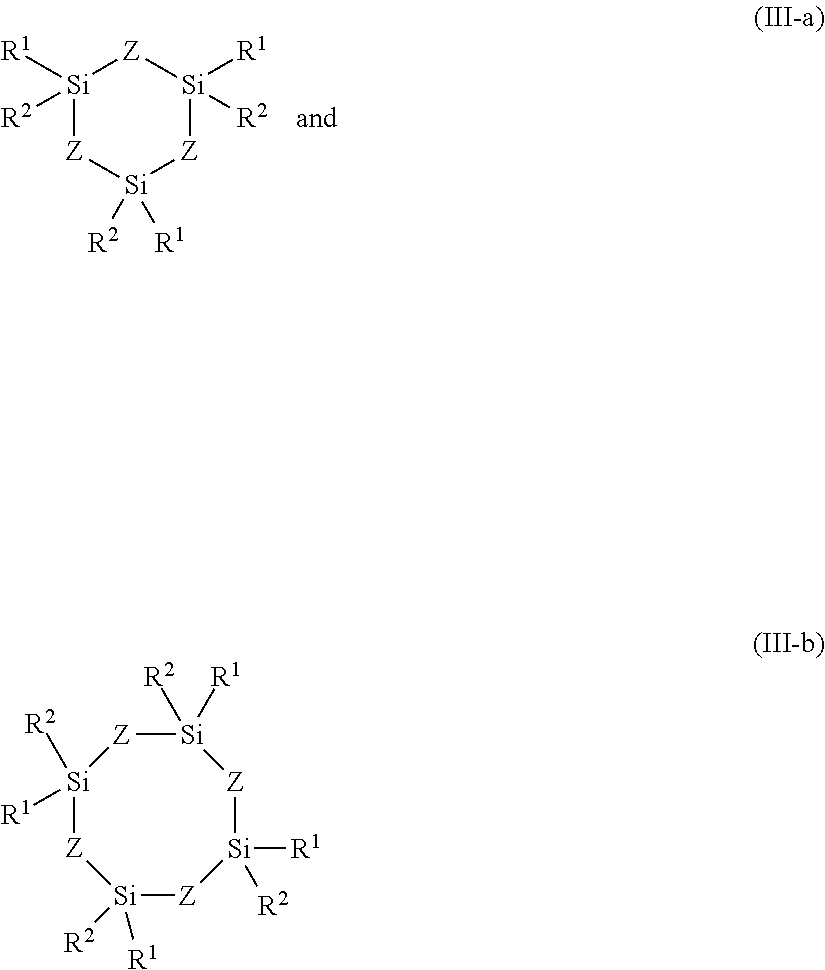Silane-Functionalized Polymer And Process For Making And Using Same
- Summary
- Abstract
- Description
- Claims
- Application Information
AI Technical Summary
Benefits of technology
Problems solved by technology
Method used
Image
Examples
examples 1-2
Comparative Polymers
[0093]To a N2-purged reactor equipped with a stirrer was added 1.97 kg hexane, 0.76 kg styrene solution, and 2.21 kg butadiene solution (21.7% by wt. in hexane). The reactor was charged with 3.90 mL n-butyllithium solution, followed by 0.5 mL KTA solution and 0.3 mL 2,2-bis(2′-tetrahydrofuryl)propane solution. The reactor jacket was heated to 50° C. and, after ˜36 minutes, the batch temperature peaked at ˜75° C.
[0094]After an additional ˜32 minutes, portions of the polymer cement were dropped into dried glass bottles.
[0095]To one bottle was added isopropanol, and this control polymer is identified as sample CL-1 in Table 1 below.
[0096]To the other bottle was added 0.17 mL 3.0 M 3-(1,3-dimethylbutylidene)aminopropyltriethoxysilane, and this comparative polymer is identified as sample CP-2 in Table 1 below.
[0097]The bottles containing each of samples 1 and 2 were kept in a 50° C. water bath for ˜30 minutes before the polymer cements were dropped separately into iso...
examples 3-4
Polymers
[0098]The polymerization from Examples 1-2 was repeated. The peak temperature of ˜75° C. was reached after ˜31 minutes. Approximately 30 minutes after peak temperature was reached, ˜6.2 mL hexamethylcyclotrisiloxane solution (1.0 M in hexane) was charged, and the polymer cement was stirred at ˜50° C. for ˜30 minutes before being dropped into dried glass bottles.
[0099]To one bottle was added isopropanol, and this control polymer is identified as sample CP-3 in Table 1 below.
[0100]To the other bottle was added sufficient 1.0 M TBAF solution to provide a TBAF-to-Li ratio of ˜3:5, and this comparative polymer is identified as sample CP-4 in Table 1 below.
[0101]The bottles containing each of samples 3 and 4 were kept in a 50° C. water bath for ˜30 minutes before the polymer cements were dropped separately into isopropanol containing BHT and then drum dried.
example 5
lized Polymer
[0102]The polymerization from Examples 1-2 was repeated. The peak temperature of ˜75° C. was reached after ˜30 minutes. Approximately 30 minutes after peak temperature was reached, ˜6.2 mL hexamethylcyclotrisiloxane solution (1.0 M in hexane) was charged, and the polymer cement was stirred at ˜50° C. for ˜30 minutes before being dropped into a dried glass bottle.
[0103]To the bottle was added (1) 0.13 mL 1,2-bis(trimethoxysilyl)ethane (3.96 M), (2) 0.13 mL N-(2-aminoethyl)-3-aminopropyltriethoxysilane (3.75 M) and (3) sufficient 1.0 M TBAF solution to provide a TBAF-to-Li+ ratio of ˜3:5. The bottle was kept in a 50° C. water bath for ˜30 minutes before the polymer cement was dropped into isopropanol containing BHT and then drum dried. This polymer is identified as sample 5 in Table 1 below.
PUM
| Property | Measurement | Unit |
|---|---|---|
| Volume | aaaaa | aaaaa |
| Fraction | aaaaa | aaaaa |
| Energy | aaaaa | aaaaa |
Abstract
Description
Claims
Application Information
 Login to View More
Login to View More - R&D
- Intellectual Property
- Life Sciences
- Materials
- Tech Scout
- Unparalleled Data Quality
- Higher Quality Content
- 60% Fewer Hallucinations
Browse by: Latest US Patents, China's latest patents, Technical Efficacy Thesaurus, Application Domain, Technology Topic, Popular Technical Reports.
© 2025 PatSnap. All rights reserved.Legal|Privacy policy|Modern Slavery Act Transparency Statement|Sitemap|About US| Contact US: help@patsnap.com



